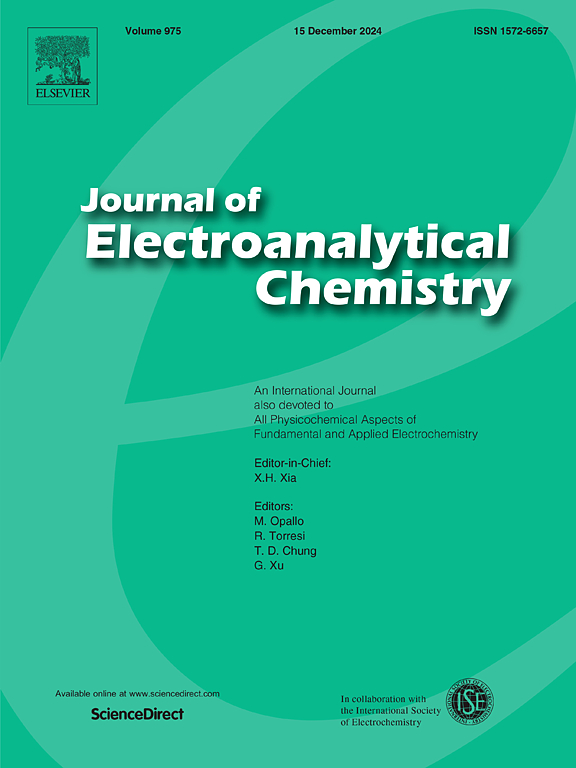Simulation of cyclic voltammograms for 3D diffusion-controlled growth and dissolution of new phase nuclei
IF 4.1
3区 化学
Q1 CHEMISTRY, ANALYTICAL
引用次数: 0
Abstract
The regularities of diffusion-controlled growth and dissolution of a large random ensemble of hemispherical nuclei on an indifferent macroelectrode surface are analyzed using the proposed model under potential sweep conditions. The model considers the relationship between the concentration profiles to the nucleus due to spherical diffusion and to the electrode due to planar diffusion, and the distribution function of Voronoi cell areas. The simulated cyclic voltammograms (CVs) reproduce all the characteristic features of experimental CVs for 3D nucleation/growth processes. The influence of the number density of nuclei and scan parameters on the calculated CVs is studied. It is shown that an increase in the scan rate and a decrease in the number density of nuclei can lead to a significant transformation of the CV cathodic part up to the formation of a current loop. Furthermore, a shift of the peak potential in the cathodic direction can be observed as the scan rate increases in the case of 3D diffusion-controlled growth. The discrepancy with the Berzins-Delahay model is discussed and an approach is proposed for determining the diffusion coefficient of depositing ions in the case of a nonlinear dependence of the peak current density on the square root of the scan rate. The influence of the Voronoi cell area and scan parameters on the nucleus size evolution and size distribution is analyzed.

三维扩散控制新相核生长和溶解的循环伏安模拟
在电位扫描条件下,利用所提出的模型分析了半球形核在不同大电极表面上的扩散控制生长和溶解的规律。该模型考虑了由于球形扩散而与原子核的浓度分布曲线和由于平面扩散而与电极的浓度分布曲线之间的关系,以及Voronoi细胞面积的分布函数。模拟的循环伏安图(cv)再现了三维成核/生长过程中实验cv的所有特征。研究了核数密度和扫描参数对计算cv的影响。结果表明,增大扫描速率和减小核数密度可导致CV阴极部分发生显著转变,直至形成电流环。此外,在三维扩散控制生长的情况下,随着扫描速率的增加,可以观察到阴极方向的峰值电位的移动。讨论了与Berzins-Delahay模型的差异,并提出了在峰值电流密度与扫描速率平方根非线性依赖的情况下确定沉积离子扩散系数的方法。分析了Voronoi细胞面积和扫描参数对细胞核大小演化和大小分布的影响。
本文章由计算机程序翻译,如有差异,请以英文原文为准。
求助全文
约1分钟内获得全文
求助全文
来源期刊
CiteScore
7.80
自引率
6.70%
发文量
912
审稿时长
2.4 months
期刊介绍:
The Journal of Electroanalytical Chemistry is the foremost international journal devoted to the interdisciplinary subject of electrochemistry in all its aspects, theoretical as well as applied.
Electrochemistry is a wide ranging area that is in a state of continuous evolution. Rather than compiling a long list of topics covered by the Journal, the editors would like to draw particular attention to the key issues of novelty, topicality and quality. Papers should present new and interesting electrochemical science in a way that is accessible to the reader. The presentation and discussion should be at a level that is consistent with the international status of the Journal. Reports describing the application of well-established techniques to problems that are essentially technical will not be accepted. Similarly, papers that report observations but fail to provide adequate interpretation will be rejected by the Editors. Papers dealing with technical electrochemistry should be submitted to other specialist journals unless the authors can show that their work provides substantially new insights into electrochemical processes.

 求助内容:
求助内容: 应助结果提醒方式:
应助结果提醒方式:


